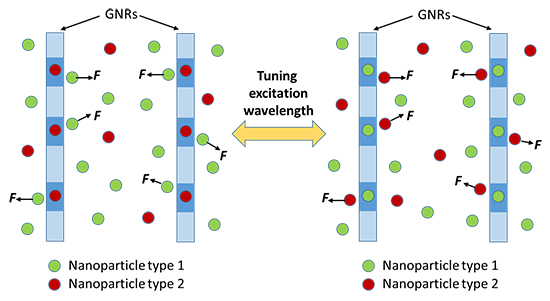Significance
Different optical trapping techniques, such as plasmonic and optical tweezers, have been developed to manipulate microscopic objects. These tweezers have improved optical trapping performance by overcoming the diffraction limit responsible for limiting the trapping capability. Consequently, plasmonic tweezers benefit from the large near-field confinement of the plasmonic structures to allow the trapping of a wide range of objects with sizes up to nanometer levels.
Nevertheless, metal-based plasmonic tweezers have major limitations that threaten their application scope. They lack real-time tunability making it difficult to tune the optical force for accurate and flexible object manipulation. Additionally, most are based on visible or near-infrared excitation sources, which present a significant challenge in confining light to desired length scale at longer wavelengths. Such excitation sources are associated with undesirable changes or potential damage to sensitive trapped objects. To address these limitations, it is imperative to extend these techniques to lower photon energy spectral region like mid-infrared (MIR) or beyond.
To this end, MIR plasmonic structures have attracted growing research attention. The MIR excitation-induced optical force can also be combined with different infrared spectroscopy methods to perform different functionalities, like probing chemical-specific information. Recently, graphene has been identified as an ideal candidate for tunable MIR plasmonics. In the MIR region, graphene plasmonic resonances have relatively higher field enhancement and confinement suitable for overcoming the disadvantages of longer wavelengths. Moreover, its resonance frequency can be easily tuned by modifying the graphene carrier density for effective control of the induced optical force.
Numerous studies on graphene-based MIR plasmonic tweezers have been reported. However, most of these studies treated trapped objects as dielectric nanoparticles with negligible permittivity dispersion, which is not true in real life as most materials exhibit large permittivity dispersion in the MIR region. Herein, Puspita Paul and Assistant Professor Peter Liu from the University at Buffalo investigated the characteristic properties of bipolar optical forces induced by MIR graphene nanoribbon (GNR) plasmonic tweezers on nanoparticles in the MIR spectral region and their applicability in sorting nanoscale objects. The work is currently published in the journal, Advanced Optical Materials.
The authors showed that most materials exhibit relatively large permittivity dispersions in the MIR region, which can drastically modify the characteristic properties of optical force induced on nanoparticles of those materials. By exploiting the large frequency tunability and high field confinement of the MIR graphene plasmonics, versatile and high-performance MIR plasmonic tweezers were realized. These tweezers can be used to selectively repel or trap nanoscale objects of various materials in a dynamically reconfigurable fashion.
Owing to the permittivity dispersions, the nanoparticle polarizability could have either negative or positive values in different spectral windows, leading to either trapping or repulsive force in the vicinity of the tunable MIR plasmonic resonance. As a result, optical trapping and manipulation based on MIR excitation offered additional functionalities and benefits than techniques based on visible and near-infrared spectrums. The new functionalities were complementary to those of existing plasmonic and optical tweezers based on near-infrared and visible excitation sources and were used for sorting and separating nanoparticles in mixtures and selective filtering.
In summary, the Paul-Liu study extended the existing optical sorting and fractionation techniques to the MIR spectral region to realize MIR graphene plasmonic tweezers with improved performance in a dynamically reconfigurable manner. This new approach is applicable to a wide range of materials exhibiting strong permittivity dispersions in MIR region attributed to their intrinsic molecular vibrations, infrared-active optical phonons and intersubband transitions. In a statement to Advances in Engineering, Professor Peter Liu explained the study findings would “pave the way for developing MIR plasmonic tweezers technologies which will not only provide new capabilities and functionalities that complement the existing optical tweezers and plasmonic tweezers, but also enable a wide range of novel applications in nano and quantum science and technologies”.


Reference
Paul, P., & Liu, P. (2021). Dynamically Reconfigurable Bipolar Optical Gradient Force Induced by Mid‐Infrared Graphene Plasmonic Tweezers for Sorting Dispersive Nanoscale Objects. Advanced Optical Materials, 10(3), 2101744.
 Advances in Engineering Advances in Engineering features breaking research judged by Advances in Engineering advisory team to be of key importance in the Engineering field. Papers are selected from over 10,000 published each week from most peer reviewed journals.
Advances in Engineering Advances in Engineering features breaking research judged by Advances in Engineering advisory team to be of key importance in the Engineering field. Papers are selected from over 10,000 published each week from most peer reviewed journals.


